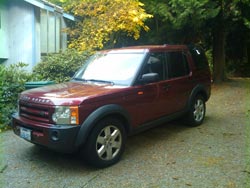T-Mobile Google G1 Phone review Part 3
A poor camera, and no real reason to buy
one - yet
|
|
The G1 can also be used
with the slider closed, of course.
If all you want to do is
dial a phone number, pressing the green dial button on the
bottom left opens up a touch screen dial pad and allows you
to dial phone numbers without needing to open the slider and
access the keyboard at all.
Part three of a three part
series on the Google/T-mobile G1 - please
also visit
1.
About the
G1 in General
2.
Using the G1
3.
Sample images, the future,
and should you buy one
|
The G1's camera is
disappointing, although it is not particularly inferior to that
of other cell phone cameras.
Overall, while the phone is
good in many respects, it is great in no respects. Its
lack of excellence in any particular area means that no
particular type of user will find a strong reason to
preferentially choose the G1 over other phones which better
provide the specific features and functions they seek.
However, we predict that the
Google Android OS and the phones which use this OS will
massively and quickly improve, so the rather disappointing
showing of this first model Google phone does not mean that
future models will not become more compelling.
The Camera
The G1 has a built in
3 megapixel camera. It has no flash and isn't capable of taking video.
An interesting added feature
is that the camera can integrate with the built in GPS so that
you can store your location data in the picture - not visibly in
the picture, but in the somewhat hidden file data associated
with the picture.
The camera is not very good,
but that is not surprising - I've yet to see any phone with a
decent built in camera. The camera seems to have a very
slow shutter speed, and also is not very sensitive in lower
light conditions (which is also unsurprising when you see how
small the camera lens is - the bigger the lens, the more light
which can be admitted and the better the camera will work in
lower light conditions).
The camera is slow to start,
and it is difficult to take a picture - pressing the shutter
button often causes you to move the camera right at the instant
you're taking a picture.
There's also no easy way to
view the image, and to zoom in on it to check for focus and
clarity, immediately after taking a picture. Instead you
have to save it, then switch to viewing pictures mode, and call
it back up on the screen to look at.
One nice feature of the
camera is that it can actually focus itself, rather than having
a fixed focus lens. The focusing is done automatically,
and doesn't actually seem to make much difference in the final
pictures.
Unusually, you can't change
any of the camera settings. You can't alter the size of
the image, and neither can you alter the amount of compression
each image has. So every picture is full size (2048 x
1536) and moderately compressed. Image file sizes range
from about 450kB to 750kB, depending on how much compression the
jpg program can automatically do to the picture.
Here are three sample
images. The pictures below have been shrunk from full-size
to fit onto this page - if you click on them, that will open
them full size in separate browser windows. Note that
all pictures tend to look better when shrunk down in size - if
you want to get a true feeling for the underlying quality, open
them full size (they will more than fill your screen).
The full size pictures have
been unretouched.
|
Picture 1 - Outdoors, good
quality |

An outdoors picture
|
This was a surprisingly good picture in almost every respect
(by phone camera standards). It is reasonably sharp
and detailed, and has detail in both the highlights (bright
parts) and shadows.
If the camera could reliably take pictures of this quality,
it would be much more useful. |
|
Picture 2 - Outdoors, some
quality anomalies |

My much photographed dog, Katia, kindly agrees to be a model
one more time
|
This is a strange picture, because when you look at it
carefully, you'll see that it is reasonably sharp and in
focus at the top and bottom, but there's a band in the
middle that is blurry - very unfortunate, because that is
where the subject of the picture is located.
It is hard to understand what caused this blurriness.
It isn't a focus issue, because the middle of the picture is
also in the middle of the distance range. And it isn't
dirt on the lens or anything, because the photo was taken
within a minute of taking the preceding picture, above, of
the car.
And it isn't a blur due to camera movement/slow shutter
speed, because that would affect the entire image equally.
Detail in the highlights (Katia's hind leg) is also
completely washed out.
A
poor quality picture. |
|
Picture 3 - Indoors, poor detail |

My 4 yr old daughter Anna at a local mall's food court
|
I'm giving the camera the benefit
of the doubt here. I took multiple pictures of Anna,
and this is the best of them, with me taking special care to
hold the camera as steadily as possible, and asking Anna to
stay as still as possible.
The picture is fair in quality.
The highlights are washed out (eg the lights in the
background) and the image details - eg of Anna's face - are
soft and fuzzy rather than sharp and distinct.
But she's such a lovely little
girl, it is hard not to love the picture, technical
imperfections notwithstanding! |
The Market
The 'Market' option on the
phone connects you to the range of third party programs that can
run on your phone. This is one of the great hoped for
features of choosing a Google Android based phone - pretty much
anyone can develop applications to run on the Android OS and it
is hoped that there will be a growing library of programs of all
different types available. This concept is reminiscent of
the old Palm PDAs - if you ever had one of those, you'll
remember that there were literally thousands of different
programs you could load onto your Palm Pilot.
There's nothing new about
the concept of an open operating system that third party
developers can work with. Nokia and some other phone
manufacturers have been quietly (and largely ineffectively)
offering their Symbian OS on a limited number of phones.
More recently, Apple has opened up its iPhone OS, and now allows
anyone to develop applications for the iPhone, although it has a
fairly restrictive policy about which applications it will then
feature in its online application listing.
With phones becoming
increasingly 'intelligent', with better screens, faster data,
cameras and GPS capabilities, and phones becoming an inseparable
part of ourselves, the range of applications that can be added
to a phone is growing massively, and is now limited only by the
imagination of the developers.
At present there are very
few applications in the Market option, and some major omissions,
but most of the programs that are available are free, and new
applications are being added every day. Almost certainly,
in a few months time all the most common applications will be
available, while more and more uncommon applications will
continue to be added as well.
There may be some problems,
though, if you go overboard in adding applications to your
phone. There's only 128MB of storage on your phone for
applications, so sooner or later, you're going to run out of
space for more programs.
With memory as inexpensive
and small as it is these days, there's little excuse for such a
miserly space for applications.
Oh - one thing about
Google's Android operating system. In common with just
about every other sophisticated operating system these days, it
has
security vulnerabilities, with the first one being announced
a mere two days after the phone went on sale. Ooops.
The Future of Google Android
Based Phones
My review is in many places
critical of the phone hardware and the software/capabilities
than runs on the phone.
But it is important to
realize that we are experiencing the first phone to use this new
operating system. Of course, that doesn't excuse hardware
limitations that an experienced and quality phone manufacturer
such as HTC should have better handled (like short battery life
and poor camera quality), and neither does it necessarily excuse
poor functionality.
But the future is exciting.
Several other phone handset manufacturers are known to be
working on their own versions of phones using Android (ie
Motorola and Kyocera). For sure, the Android OS will be
enhanced substantially and rapidly. And, best of all, the
open ended and - at least in theory - massive capabilities of
the phone hardware allows for and encourages the ongoing
development of many new programs to address the current
weaknesses and omissions of the G1 phone.
Today, the G1 does not offer
you a compelling reason to purchase it. But wait six
months, and not only will the G1 be much better than it is
today, but there will also probably be competing phones from
other manufacturers, and running on other networks as well
as/instead of T-mobiles, and there'll be many more programs and
capabilities on the G1 and the newer phones.
Updates to the G1
One nice thing about the G1
and T-mobile's management of the phone and its software is that
updates to the phone's operating system and software are
automatically sent to the phone via its data connection.
T-mobile tell me they have
already released some updates and fixes, and are aggressively
working on continuing to improve areas of uncovered weakness.
At least until such time as the G1 is no longer a current
product, and no longer T-mobile's highest visibility flagship
phone, it is probable to expect that a lot of resource and
attention will be given to the phone and its features.
Most of the problems with
the phone are software based rather than hardware based, and so
if you do buy a G1 now, you can expect future enhancements on an
ongoing basis.
Should You Buy a T-mobile G1?
The T-mobile G1 is not a bad
phone, and in many respects, it is a good phone. But, is
it a great phone? No. And while good, it lacks any
particular strength to appeal to any particular group of phone
users.
If you want the slickest
sexiest phone out there, you'll get an iPhone 3G. If you
want the best phone for email, you'll get a Blackberry.
And if you want a phone primarily for phone calls alone, you'll
get anything else at all that is less expensive and doesn't
require an extra $35/month for a data plan you're unlikely to
get value from.
In other words, the G1 slips
through the cracks of the current marketplace, and offers no-one
a compelling reason to buy it. And with a phone that comes
bundled with a two year service contract commitment and a
mandatory and expensive data plan, it isn't a phone you'd
lightly buy without a strong reason to do so.
One more consideration to
keep in mind - if you're considering a G1 because of its 3G data
capabilities, do be sure to check what type of 3G coverage is
available in your area. T-mobile is still rolling out its
3G coverage, and if you're not in a major metropolitan area, you
may find there's no 3G available.
So, to answer our question,
no, you shouldn't buy a G1. But - stay tuned. The G1
will get better, and competing phones will also come out to
broaden your range of choices. Although the G1 is not a
good choice for anyone today, the chances are that, sometime in
the next year or so, the G1 and its new successors and
competitors may become much more compelling for many more
people.
Part three of a three part
series on the Google/T-mobile G1 - please
also visit
1.
About the
G1 in General
2.
Using the G1
3.
Sample images, the future,
and should you buy one
Related Articles, etc
|
If so, please donate to keep the website free and fund the addition of more articles like this. Any help is most appreciated - simply click below to securely send a contribution through a credit card and Paypal.
|
Originally published
31 Oct 2008, last update
21 Jul 2020
You may freely reproduce or distribute this article for noncommercial purposes as long as you give credit to me as original writer.
|

